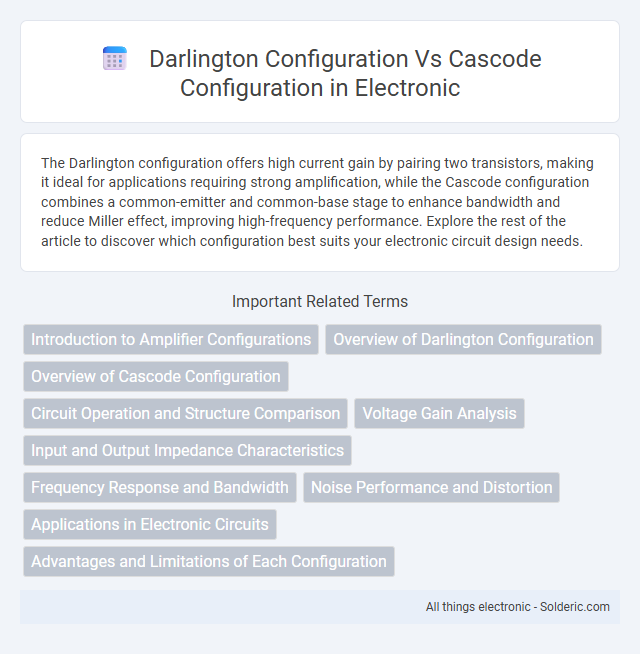The Darlington configuration offers high current gain by pairing two transistors, making it ideal for applications requiring strong amplification, while the Cascode configuration combines a common-emitter and common-base stage to enhance bandwidth and reduce Miller effect, improving high-frequency performance. Explore the rest of the article to discover which configuration best suits your electronic circuit design needs.
Comparison Table
| Feature | Darlington Configuration | Cascode Configuration |
|---|---|---|
| Primary Use | High current gain amplification | High frequency and high gain applications |
| Gain | Very high current gain (product of two transistors) | Moderate voltage gain with improved bandwidth |
| Frequency Response | Limited bandwidth due to increased input capacitance | Extended bandwidth, reduced Miller effect |
| Output Voltage Swing | Reduced because of two V_BE drops | Better output voltage headroom |
| Input Impedance | High input impedance | Moderate input impedance |
| Noise Performance | Higher noise due to extra transistor junction | Lower noise and improved linearity |
| Complexity | Simple two-transistor arrangement | More complex biasing and design |
| Applications | Power amplifiers, switching circuits | RF amplifiers, low-noise amplifiers |
Introduction to Amplifier Configurations
Darlington and Cascode configurations are popular transistor amplifier setups known for their distinct performance characteristics. The Darlington configuration combines two bipolar transistors to provide high current gain and input impedance, ideal for applications requiring strong signal amplification. In contrast, the Cascode configuration pairs a common-emitter stage with a common-base stage to achieve high gain and improved bandwidth while minimizing Miller effect distortion, enhancing your amplifier's frequency response and stability.
Overview of Darlington Configuration
The Darlington configuration consists of two bipolar transistors connected to amplify current, providing a high current gain typically around the product of the individual transistor gains. This setup allows Your circuit to achieve increased input impedance and enhanced current amplification in compact form. It is widely used in applications that require high gain, such as audio amplifiers and switching circuits.
Overview of Cascode Configuration
The Cascode configuration combines a common-emitter stage with a common-base stage to achieve high gain and improved bandwidth while minimizing Miller effect capacitance. This arrangement enhances input-output isolation and reduces distortion, making it ideal for high-frequency applications. Your circuits benefit from the Cascode's superior voltage gain and improved stability compared to traditional Darlington pairs.
Circuit Operation and Structure Comparison
The Darlington configuration consists of two bipolar junction transistors (BJTs) connected in a way that the current amplified by the first transistor is further amplified by the second, resulting in high current gain and simplified biasing but increased output saturation voltage. In contrast, the Cascode configuration combines a common-emitter stage with a common-base stage, offering high gain, improved bandwidth, and reduced Miller capacitance, which leads to better high-frequency performance. Structurally, Darlington pairs have transistors connected emitter-to-base to maximize current gain, while Cascode stages stack transistors vertically to enhance voltage gain and frequency response.
Voltage Gain Analysis
Darlington configuration offers high voltage gain by combining two bipolar transistors in a cascade, effectively multiplying their current gains and resulting in a higher overall transistor gain (b_total b1 x b2). Cascode configuration enhances voltage gain by stacking a common-emitter amplifier with a common-base stage, which significantly increases output resistance and reduces the Miller effect, leading to improved gain-bandwidth product and stability. While Darlington amplifiers excel in current gain, cascode circuits provide superior voltage gain with better frequency response and reduced distortion.
Input and Output Impedance Characteristics
Darlington configuration exhibits very high input impedance due to the combined gain of two transistors, making it ideal for high-impedance signal sources, whereas its output impedance remains relatively low but can suffer from higher saturation voltage. Cascode configuration offers moderate input impedance with improved high-frequency response and significantly reduced Miller capacitance, resulting in much lower output impedance compared to single-transistor stages. Your choice depends on prioritizing either the ultra-high input impedance of Darlington pairs or the low output impedance and enhanced bandwidth benefits of the cascode arrangement.
Frequency Response and Bandwidth
Darlington configurations exhibit higher input impedance and current gain but suffer from limited frequency response and reduced bandwidth due to increased parasitic capacitances and transistor junction capacitances. Cascode configurations enhance frequency response by minimizing the Miller effect and reducing input capacitance, resulting in significantly improved bandwidth and faster transient response. The cascode topology is preferred in high-frequency applications where maintaining gain while extending bandwidth is critical.
Noise Performance and Distortion
The Darlington configuration typically exhibits higher noise levels due to the compounded base current shot noise from its two transistors, which can degrade overall signal fidelity. In contrast, the Cascode configuration provides superior noise performance by reducing the Miller effect and input capacitance, resulting in lower noise figure especially at high frequencies. When it comes to distortion, the Cascode topology offers enhanced linearity and reduced distortion by isolating gain stages, whereas the Darlington configuration may introduce increased harmonic distortion due to its compounded transistor stages.
Applications in Electronic Circuits
Darlington configurations are widely used in power amplifiers and switching circuits due to their high current gain, making them ideal for driving heavy loads such as motors and relays. Cascode configurations excel in RF amplifiers and high-frequency analog circuits by offering high gain and improved bandwidth while minimizing Miller effect capacitance. Both configurations optimize transistor performance but target different application areas based on their frequency response and gain characteristics.
Advantages and Limitations of Each Configuration
The Darlington configuration offers high current gain and simplified biasing, making it ideal for low-power amplification but suffers from increased voltage drop and slower switching speeds. The Cascode configuration improves frequency response and reduces the Miller effect, enhancing high-frequency performance and output impedance, yet it involves more complex biasing and higher voltage requirements. Both configurations trade off between gain, speed, voltage handling, and complexity depending on the application.
Darlington configuration vs Cascode configuration Infographic

 solderic.com
solderic.com